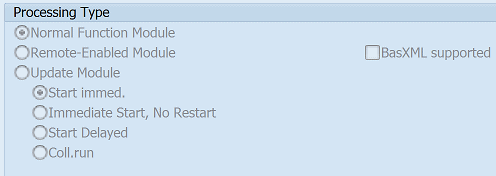SAP BAPI_PO_GET_LIST Function Module for List Purchase Orders - Only up to 4.0A
BAPI_PO_GET_LIST is a standard bapi po get list SAP function module available within SAP R/3 or S/4 Hana systems, depending on your version and release level. It is used for List Purchase Orders - Only up to 4.0A processing and below is the pattern details for this FM, showing its interface including any import and export parameters, exceptions etc. there is also a full "cut and paste" ABAP pattern code example, along with implementation ABAP coding, documentation and contribution comments specific to this or related objects.
See here to view full function module documentation and code listing for bapi po get list FM, simply by entering the name BAPI_PO_GET_LIST into the relevant SAP transaction such as SE37 or SE38.
Function Group: MEWP
Program Name: SAPLMEWP
Main Program: SAPLMEWP
Appliation area: M
Release date: 17-Sep-1997
Mode(Normal, Remote etc): Remote-Enabled
Update:

Function BAPI_PO_GET_LIST pattern details
In-order to call this FM within your sap programs, simply using the below ABAP pattern details to trigger the function call...or see the full ABAP code listing at the end of this article. You can simply cut and paste this code into your ABAP progrom as it is, including variable declarations.CALL FUNCTION 'BAPI_PO_GET_LIST'"List Purchase Orders - Only up to 4.0A.
EXPORTING
* REL_GROUP = "Release Group
* REL_CODE = "Release Code
* ITEMS_FOR_RELEASE = 'X' "Indicator: Display Purchase Orders Awaiting Release Only
TABLES
PO_HEADERS = "PO Header Data
* PO_ADDRESSES = "Vendor Address for SAP Releases < 4.0A
* PO_ADDRESSES_NEW = "Vendor Address for SAP Releases >= 4.0A
PO_ITEMS = "Purchase Order Items
* RETURN = "Processing Errors That Occurred
EXCEPTIONS
REL_CODE_MISSING = 1 REL_AUTHORITY_CHECK_FAILED = 2
Customer Function user exits
Below is a list of CUSTOMER FUNCTION exit user exits that are available within this program and maybe relevant for this FM.EXIT_SAPLMEWP_001 Customer Exit for Object Determination (Procurement via Catalogs)
EXIT_SAPLMEWP_002 Customer Exit: Creation of Purchase Order via BAPI_PO_CREATE
EXIT_SAPLMEWP_003 Customer Exit to Determine Allowed Catalogs
IMPORTING Parameters details for BAPI_PO_GET_LIST
REL_GROUP - Release Group
Data type: BAPIMMPARA-REL_GROUPOptional: Yes
Call by Reference: No ( called with pass by value option)
REL_CODE - Release Code
Data type: BAPIMMPARA-REL_CODEOptional: Yes
Call by Reference: No ( called with pass by value option)
ITEMS_FOR_RELEASE - Indicator: Display Purchase Orders Awaiting Release Only
Data type: BAPIMMPARA-SELECTIONDefault: 'X'
Optional: Yes
Call by Reference: No ( called with pass by value option)
TABLES Parameters details for BAPI_PO_GET_LIST
PO_HEADERS - PO Header Data
Data type: BAPIEKKOOptional: No
Call by Reference: No ( called with pass by value option)
PO_ADDRESSES - Vendor Address for SAP Releases < 4.0A
Data type: BAPIEKANOptional: Yes
Call by Reference: No ( called with pass by value option)
PO_ADDRESSES_NEW - Vendor Address for SAP Releases >= 4.0A
Data type: BAPIADDRESSOptional: Yes
Call by Reference: No ( called with pass by value option)
PO_ITEMS - Purchase Order Items
Data type: BAPIEKPOOptional: No
Call by Reference: No ( called with pass by value option)
RETURN - Processing Errors That Occurred
Data type: BAPIRETURNOptional: Yes
Call by Reference: No ( called with pass by value option)
EXCEPTIONS details
REL_CODE_MISSING - Release Code Missing
Data type:Optional: No
Call by Reference: No ( called with pass by value option)
REL_AUTHORITY_CHECK_FAILED - No Authorization to Release
Data type:Optional: No
Call by Reference: No ( called with pass by value option)
Copy and paste ABAP code example for BAPI_PO_GET_LIST Function Module
The ABAP code below is a full code listing to execute function module POPUP_TO_CONFIRM including all data declarations. The code uses the original data declarations rather than the latest in-line data DECLARATION SYNTAX but I have included an ABAP code snippet at the end to show how declarations would look using the newer method of declaring data variables on the fly. This will allow you to compare and fully understand the new inline method. Please note some of the newer syntax such as the @DATA is not available until a later 4.70 service pack (SP8), which i why i have stuck to the origianl for this example.| DATA: | ||||
| lv_rel_group | TYPE BAPIMMPARA-REL_GROUP, " | |||
| lt_po_headers | TYPE STANDARD TABLE OF BAPIEKKO, " | |||
| lv_rel_code_missing | TYPE BAPIEKKO, " | |||
| lv_rel_code | TYPE BAPIMMPARA-REL_CODE, " | |||
| lt_po_addresses | TYPE STANDARD TABLE OF BAPIEKAN, " | |||
| lv_rel_authority_check_failed | TYPE BAPIEKAN, " | |||
| lt_po_addresses_new | TYPE STANDARD TABLE OF BAPIADDRESS, " | |||
| lv_items_for_release | TYPE BAPIMMPARA-SELECTION, " 'X' | |||
| lt_po_items | TYPE STANDARD TABLE OF BAPIEKPO, " | |||
| lt_return | TYPE STANDARD TABLE OF BAPIRETURN. " |
| CALL FUNCTION 'BAPI_PO_GET_LIST' "List Purchase Orders - Only up to 4.0A |
| EXPORTING | ||
| REL_GROUP | = lv_rel_group | |
| REL_CODE | = lv_rel_code | |
| ITEMS_FOR_RELEASE | = lv_items_for_release | |
| TABLES | ||
| PO_HEADERS | = lt_po_headers | |
| PO_ADDRESSES | = lt_po_addresses | |
| PO_ADDRESSES_NEW | = lt_po_addresses_new | |
| PO_ITEMS | = lt_po_items | |
| RETURN | = lt_return | |
| EXCEPTIONS | ||
| REL_CODE_MISSING = 1 | ||
| REL_AUTHORITY_CHECK_FAILED = 2 | ||
| . " BAPI_PO_GET_LIST | ||
ABAP code using 7.40 inline data declarations to call FM BAPI_PO_GET_LIST
The below ABAP code uses the newer in-line data declarations. This allows you to see the coding differences/benefits of the later inline syntax. Please note some of the newer syntax below, such as the @DATA is not available until 4.70 EHP 8.| "SELECT single REL_GROUP FROM BAPIMMPARA INTO @DATA(ld_rel_group). | ||||
| "SELECT single REL_CODE FROM BAPIMMPARA INTO @DATA(ld_rel_code). | ||||
| "SELECT single SELECTION FROM BAPIMMPARA INTO @DATA(ld_items_for_release). | ||||
| DATA(ld_items_for_release) | = 'X'. | |||
Search for further information about these or an SAP related objects